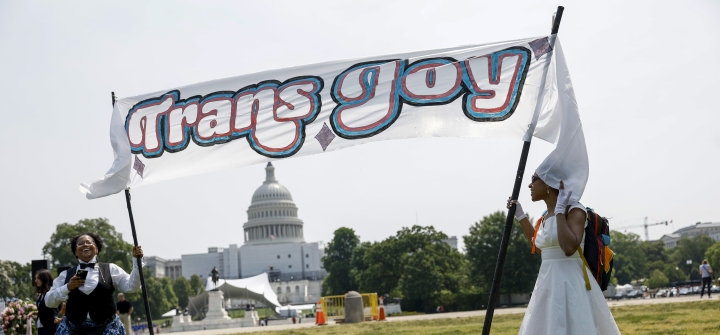LGBTQ Youth: Under Attack and Fighting Back
US states have advanced a record number of laws in recent years that attack LGBTQ rights—especially for transgender youth.
More than a dozen states have passed laws banning or criminalizing the provision of age-appropriate transgender medical care to minors—such as puberty blockers, hormones, and surgery, as well as social support and mental health services. Dozens more bills have sought to weaken nondiscrimination laws, limit trans youths’ participation in school activities or their access to public bathrooms.
These policy efforts take a serious toll on the mental health of LGBTQ youth, according to the 2022 mental health survey from the Trevor Project—a nonprofit focused on suicide prevention for LGBTQ youth. Ronita Nath, the Trevor Project’s vice president of research, spoke with GHN about the survey findings, why we need more nuanced data on LGBTQ youth, and what gives her hope.
Why is this wave of anti-LGBTQ policies happening now?
After decades of fighting for acceptance and equal treatment under the law, the LGBTQ community has really gained momentum, and greater visibility in the media, government, and public affairs than ever before. But this success has been met with increasingly intense backlash, particularly at the expense of the transgender community in recent years.
The relentless anti-LGBTQ attacks we’re seeing in politics have incited threats of violence against LGBTQ people and the parents, the teachers and doctors who support them, and also affirming spaces—including community centers, pride events, drag shows, and hospitals and clinics that provide transgender medical care.
How do anti-LGBTQ policies impact the mental health of LGBTQ youth?
Rates of suicidal thoughts have trended upward among LGBTQ young people over the last 3 years, according to our survey, which included a diverse cohort of 34,000 LGBTQ youths ages 13-24. Nearly a third of LGBTQ young people said their mental health was poor most of the time, or always, due to anti-LGBTQ policies and legislation.
Nearly 2 in 3 LGBTQ young people said that just hearing about potential state or local laws banning people from discussing LGBTQ people at school made their mental health a lot worse.
Anti-LGBTQ laws are making headlines—but are there efforts to protect LGBTQ rights that we should also know about?
In the face of harmful public debate around these anti-LGBTQ bills, there’s a small silver lining that the overwhelming majority of these bills do not pass or become law. Last year, advocates around the US were successful in striking down nearly 9 in 10 of these bills. We’re hopeful that this will continue in 2023.
There’s a glimmer of hope in laws like the one recently signed in Minnesota that protects LGBTQ young people from the dangerous and discredited practice of conversion therapy.
In our survey, 79% of LGBTQ young people said that hearing about potential state or local laws trying to ban conversion therapy made them feel a little or a lot better.
Some of these laws ban gender-affirming care—where do major medical groups stand on that issue?
Care for transgender and non-binary youth is established best practice and recommended by every major medical and mental health association in the US.
In December 2021, the Trevor Project published the first large survey to examine gender-affirming hormone therapy among a sample of more than 9,000 transgender and non-binary individuals in the Journal of Adolescent Health. We found that gender-affirming hormone therapy is significantly related to lower rates of depression, suicidal thoughts, and suicidal attempts among transgender and non-binary young people. Specifically for young people under the age of 18, receiving gender-affirming hormone therapy was associated with nearly 40% lower odds of recent depression or a past year suicide attempt.
These data should serve as a call to action to resist bans on transgender medical care and to invest in more research on this topic so that youth and their families can make evidence informed decisions regarding care.
The Trevor Project survey noted that we still don’t have reliable counts or registries of the LGBTQ youth population. How do we get better data?
Research in this field has historically grouped all LGBTQ people together, obscuring the unique challenges and disparities across race ethnicity, sexual orientation, and gender identity.
Historically, there’s been limited data available on suicide risk among LGBTQ people due to a lack of specific funding mechanisms and a lack of data on sexual orientation and gender identity in large federal surveys. The CDC’s youth risk behavior survey is one of the most prominent government-sanctioned surveys available that includes any data on LGBTQ identity and suicide risk among young people. But it only represents the experiences of LGBQ high school students and fails to capture transgender and nonbinary identities.
Our research uncouples these various groups to really understand the experiences of LGBTQ young people who hold multiple marginalized identities. We have not only a large sample of around 30,000, but a very diverse sample size. 59% of our sample was transgender, non-binary young people, 50% of our sample was LGBTQ people of color. So we are filling the need at this time. But government institutions and fellow researchers must really apply an intersectional lens to data collection, especially for a community as diverse as LGBTQ young people, to better grasp the scope of the problems that they face, and to highlight disparities.
What else can be done federally to affirm LGBTQ rights?
We know what works, and I think it’s a matter of doing it. In terms of legislation, we need to protect LGBTQ people from conversion therapy, from anti-LGBTQ victimization like discrimination, and enact policies that expand access to competent health care which includes transgender medical care. We need to invest in LGBTQ affirming spaces and support services.
Transgender medical care plays one role in that. But that’s part of a bigger story of the anti-LGBTQ victimization that we’re seeing. That’s contributing to these the worst possible health outcome—which is suicide.
And harmful—or helpful—policies don’t just happen at the government level…
Yes. We need to create safer and affirming schools with trans-inclusive policies, including access to gender neutral bathrooms and respect for trans students, names and pronouns. In our research, we found 37% of transgender and non-binary youth had access to a gender-neutral bathroom at their school, and those who did reported lower rates of suicide risk. There has to be intolerance for anti-LGBTQ bullying and harassment within schools.
What makes you feel hopeful?
Our survey asked young people what a world would look like for all LGBTQ people were accepted.
That gave me a lot of hope they’re so hopeful. Common responses include that people would be able to express themselves and be who they want to be, that people have better mental health, that no one would ever have to worry about coming out, that there would be gender-neutral bathrooms, and no more anti-LGBTQ laws.
We’re facing a big problem, but we can all take small actions to make sure that our communities and homes are safe and affirming spaces for everyone.
Ed. Note: This interview was edited for clarity and length.
Join the 50,000+ subscribers in 170+ countries who rely on Global Health NOW summaries and exclusive articles for the latest public health news. Sign up for our free weekday newsletter, and please share the link with friends and colleagues. https://www.globalhealthnow.org/subscribe
Activists hold a banner up before the start of the "Trans Youth Prom" outside of the US Capitol building on May 22 in Washington, DC. Anna Moneymaker/Getty





